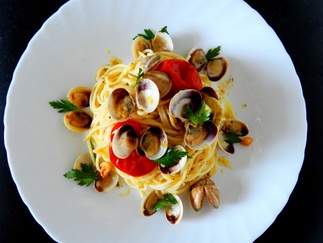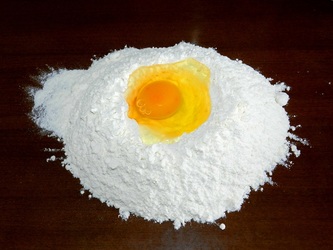
Italian food, as I have learned from observing, is really about the ingredients which should be seasonal, local and fresh and, when treated with respect, should yield delicious dishes that can be perfectly enjoyed.
Being in Naples, which has one of the most picturesque coastlines in the entire Italian peninsula, I got to see the intimate relationship of this city to the sea and how this has been so important in its history and how this also figures into the city's food culture which is rich and captivating.
As far as pasta dishes are concerned, in my opinion, it doesn't get any more Napoletano than spaghetti alle vongole (or spaghetti with clams) - it requires no more than a few ingredients, the focal point of which is the clams (of which there are different options in size and shape)... a local pride.
Ingredients:
Pasta, preferably spaghetti or any other thin strand pasta (250g makes about 3 servings)
Clams (about 300-400g)
Olive Oil
Garlic (about 3-4 cloves)
Tomatoes (optional, preferably cherry tomatoes)
Chili Flakes or Chili Powder (optional)
Parsley
1. Boil water for cooking the pasta. Once boiling cook until al dente (or "to the bite"). Package time is only a guideline - unless you're an expert, I believe trying the pasta is the only way to really perfectly cook it. Drain and prepare to add into the sauce (which should be ready by the time the pasta is cooked).
2. Make the base of the sauce which is simply an aglio e olio (garlic and oil). Heat some olive oil at low to medium heat, add the chopped cloves of garlic and lower the heat to prevent the garlic from browning rapidly - you want to draw out the garlic flavor and let it infuse into the oil.
3. If adding tomatoes and chili, time to add them to the garlic oil. If using cherry tomatoes, blister them into the pan and squash them (rather than pre-cutting them before cooking) as the juice enriches the sauce and the tomatoes become sweeter when "kissed by heat".
4. Add the clams and cook them until they all open up (normally, everything opens up but if after a long time, some stubborn ones that don't remain, they are probably bad so simply discard them). Some recipes would add white wine in this point (sometimes I do, sometimes I don't) but, following the direction of simplicity, one can omit that. Should you choose to use wine, use a dry white wine (here in Italy, I really just tend to choose locally). If very little oil remain in the pan, add some more olive oil (as this will be an essential part of the sauce).
5. Once both sauce and pasta are prepared (if the clams finish before the pasta, reduce heat... you don't want to overcook the clams), add the pasta into the sauce and mix thoroughly making sure that the sauce coats the pasta. Add some chopped parsley and plate up - pasta underneath and trying to put most of the clams on top to "showcase" them. Add more parsley and DON'T ADD CHEESE! Cheese and fish is an italian no-no (though there are known exceptions like tonnarelli, cozze e pecorino, in Rome) and I tend to agree, for the most part. In case lacking in salt, correct by sprinkling some fine salt into the dish (this happens though it's really safer to never add more salt into seafood while cooking as it could easily become too salty).
I find that clams are one of the best seafood one can really get to try here in Naples along with other shellfish like mussels (I'm craving for an 'mpepata di cozze or "peppered mussels" now) as well as things like shrimps, octopus, squid and cuttlefish. All of these would have classical ways of preparing them according to Neapolitan tradition and all most all would figure in Christmas Eve meals which, in Southern Italy, is known as the Festa del 7 Pesce (Feast of the 7 Fishes, corresponding to the tradition of having 7 different fish courses) which is still in practice up to present (I've never been in one since I celebrate Christmas either in Rome or elsewhere). Cucina napoletana also boasts of having various pastries and dessert pieces that provide scrumptious finishes to each meal (but as I'm not a strong baker, I can't exactly make them!). This rich tradition that matches the rich local history (dating up to the ancient Greeks) makes Naples one of the most special places to live in and visit in Italy.
Being in Naples, which has one of the most picturesque coastlines in the entire Italian peninsula, I got to see the intimate relationship of this city to the sea and how this has been so important in its history and how this also figures into the city's food culture which is rich and captivating.
As far as pasta dishes are concerned, in my opinion, it doesn't get any more Napoletano than spaghetti alle vongole (or spaghetti with clams) - it requires no more than a few ingredients, the focal point of which is the clams (of which there are different options in size and shape)... a local pride.
Ingredients:
Pasta, preferably spaghetti or any other thin strand pasta (250g makes about 3 servings)
Clams (about 300-400g)
Olive Oil
Garlic (about 3-4 cloves)
Tomatoes (optional, preferably cherry tomatoes)
Chili Flakes or Chili Powder (optional)
Parsley
1. Boil water for cooking the pasta. Once boiling cook until al dente (or "to the bite"). Package time is only a guideline - unless you're an expert, I believe trying the pasta is the only way to really perfectly cook it. Drain and prepare to add into the sauce (which should be ready by the time the pasta is cooked).
2. Make the base of the sauce which is simply an aglio e olio (garlic and oil). Heat some olive oil at low to medium heat, add the chopped cloves of garlic and lower the heat to prevent the garlic from browning rapidly - you want to draw out the garlic flavor and let it infuse into the oil.
3. If adding tomatoes and chili, time to add them to the garlic oil. If using cherry tomatoes, blister them into the pan and squash them (rather than pre-cutting them before cooking) as the juice enriches the sauce and the tomatoes become sweeter when "kissed by heat".
4. Add the clams and cook them until they all open up (normally, everything opens up but if after a long time, some stubborn ones that don't remain, they are probably bad so simply discard them). Some recipes would add white wine in this point (sometimes I do, sometimes I don't) but, following the direction of simplicity, one can omit that. Should you choose to use wine, use a dry white wine (here in Italy, I really just tend to choose locally). If very little oil remain in the pan, add some more olive oil (as this will be an essential part of the sauce).
5. Once both sauce and pasta are prepared (if the clams finish before the pasta, reduce heat... you don't want to overcook the clams), add the pasta into the sauce and mix thoroughly making sure that the sauce coats the pasta. Add some chopped parsley and plate up - pasta underneath and trying to put most of the clams on top to "showcase" them. Add more parsley and DON'T ADD CHEESE! Cheese and fish is an italian no-no (though there are known exceptions like tonnarelli, cozze e pecorino, in Rome) and I tend to agree, for the most part. In case lacking in salt, correct by sprinkling some fine salt into the dish (this happens though it's really safer to never add more salt into seafood while cooking as it could easily become too salty).
I find that clams are one of the best seafood one can really get to try here in Naples along with other shellfish like mussels (I'm craving for an 'mpepata di cozze or "peppered mussels" now) as well as things like shrimps, octopus, squid and cuttlefish. All of these would have classical ways of preparing them according to Neapolitan tradition and all most all would figure in Christmas Eve meals which, in Southern Italy, is known as the Festa del 7 Pesce (Feast of the 7 Fishes, corresponding to the tradition of having 7 different fish courses) which is still in practice up to present (I've never been in one since I celebrate Christmas either in Rome or elsewhere). Cucina napoletana also boasts of having various pastries and dessert pieces that provide scrumptious finishes to each meal (but as I'm not a strong baker, I can't exactly make them!). This rich tradition that matches the rich local history (dating up to the ancient Greeks) makes Naples one of the most special places to live in and visit in Italy.

 RSS Feed
RSS Feed